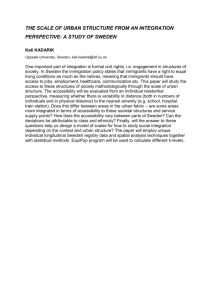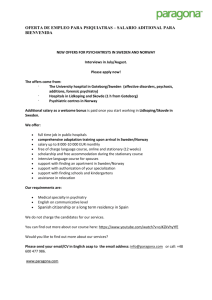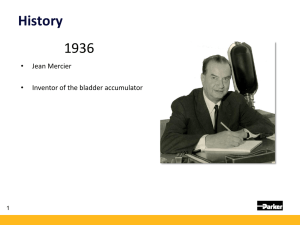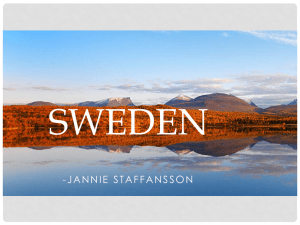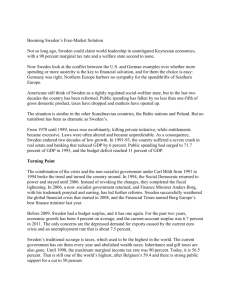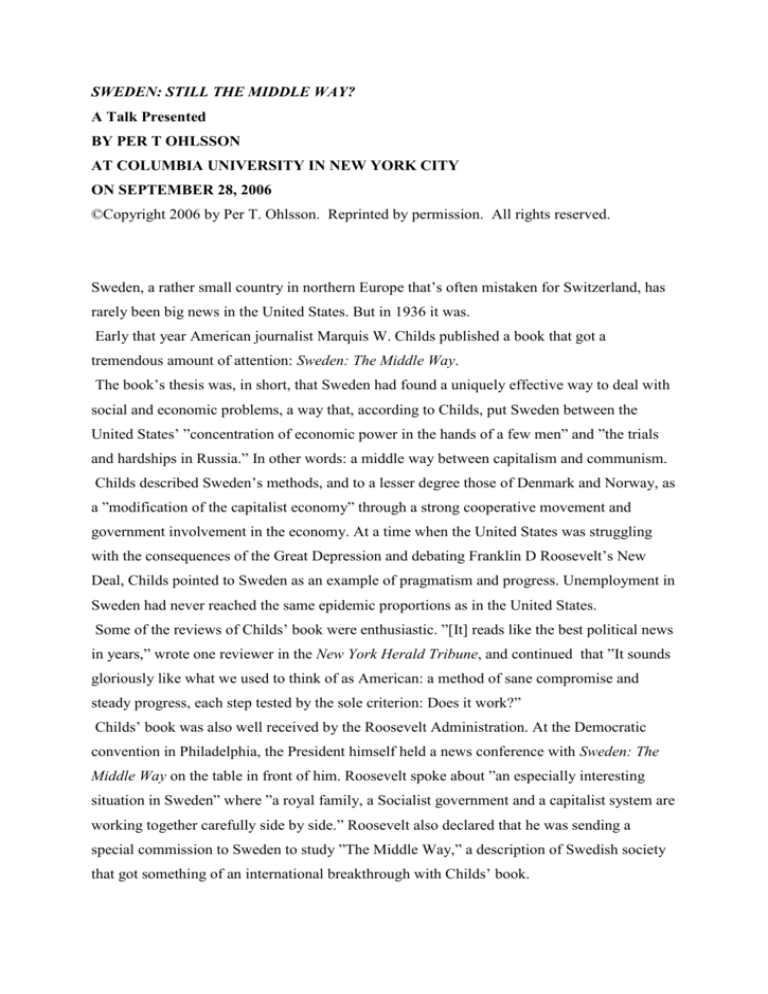
SWEDEN: STILL THE MIDDLE WAY?
A Talk Presented
BY PER T OHLSSON
AT COLUMBIA UNIVERSITY IN NEW YORK CITY
ON SEPTEMBER 28, 2006
©Copyright 2006 by Per T. Ohlsson. Reprinted by permission. All rights reserved.
Sweden, a rather small country in northern Europe that’s often mistaken for Switzerland, has
rarely been big news in the United States. But in 1936 it was.
Early that year American journalist Marquis W. Childs published a book that got a
tremendous amount of attention: Sweden: The Middle Way.
The book’s thesis was, in short, that Sweden had found a uniquely effective way to deal with
social and economic problems, a way that, according to Childs, put Sweden between the
United States’ ”concentration of economic power in the hands of a few men” and ”the trials
and hardships in Russia.” In other words: a middle way between capitalism and communism.
Childs described Sweden’s methods, and to a lesser degree those of Denmark and Norway, as
a ”modification of the capitalist economy” through a strong cooperative movement and
government involvement in the economy. At a time when the United States was struggling
with the consequences of the Great Depression and debating Franklin D Roosevelt’s New
Deal, Childs pointed to Sweden as an example of pragmatism and progress. Unemployment in
Sweden had never reached the same epidemic proportions as in the United States.
Some of the reviews of Childs’ book were enthusiastic. ”[It] reads like the best political news
in years,” wrote one reviewer in the New York Herald Tribune, and continued that ”It sounds
gloriously like what we used to think of as American: a method of sane compromise and
steady progress, each step tested by the sole criterion: Does it work?”
Childs’ book was also well received by the Roosevelt Administration. At the Democratic
convention in Philadelphia, the President himself held a news conference with Sweden: The
Middle Way on the table in front of him. Roosevelt spoke about ”an especially interesting
situation in Sweden” where ”a royal family, a Socialist government and a capitalist system are
working together carefully side by side.” Roosevelt also declared that he was sending a
special commission to Sweden to study ”The Middle Way,” a description of Swedish society
that got something of an international breakthrough with Childs’ book.
SWEDEN: THE MIDDLE WAY?
2
Decades later Allan Kastrup, who for many years worked as a Swedish information officer in
the United States, remembered the impact of Sweden:The Middle Way:
”With regard to importance and effects, Marquis Childs’ book weighs more heavily than any
other book about Sweden published in America, and it is not likely that it ever will have any
real competitors.”
The public interest and publicity that surrounded Childs’ book was, of course, noticed in
Sweden, and was seen as a sort of confirmation of Swedish methods and Swedish solutions.
Three years later, on the eve of the Second World War, the Swedish pavilion at the World’s
Fair in New York became a sensation for the same reasons that Childs’ book had become a
success. A reviewer in The Nation wrote: ”The happy little Swedish pavilion is civilization.”
What was going on in Sweden in the thirties? What made many Americans, especially within
the liberal and progressive elites, almost fall in love with Sweden and with a people that,
according to Childs, ”cultivated their garden, their rocky, remote, lonely garden, with
patience, with courage, and with an extraordinary degree of intelligence”?
Sweden’s Social Democrats, led by the legendary Per Albin Hansson, had come to power in
the election of 1932, the same year that saw Roosevelt defeat Republican Herbert Hoover in
the campaign for the presidency of the United States. One year later, Sweden’s Social
Democrats, influenced by interventionist economic ideas, entered into an important political
compromise with The Farmer’s Party, Bondeförbundet, the forerunner of today’s Center
Party. In exchange for regulations to protect Swedish agriculture, the Social Democrats
secured support for a large public works program and a more active role for the government
in efforts to combat unemployment.
This compromise or horse trade, known as ”The Cattle deal,” was successful, on the whole.
After a chaotic decade with several changes of governments, it also laid the groundwork for a
stable political situation, dominated by the Social Democrats. Except for a brief interlude in
1936, the Social Democrats were to stay in power until 1976.
Accordingly, Sweden’s ”Middle Way” became more or less synonymous with Sweden’s
Social Democrats, and especially during the Cold War, they also made every rhetorical effort
to present themselves as representing a way between unchecked capitalism and state
socialism, and, within the concept of neutrality, between the Eastern and Western blocs.
When Sweden took its seat at the United Nations in 1946, Foreign Minister Östen Undén, a
leading Social Democrat and legal scholar, made the following statement:
SWEDEN: THE MIDDLE WAY?
3
”Here in the United States … Sweden has often been called ’the country of the Middle Way’
with respect to our methods for solving domestic social problems. We are happy to accept this
characterization and would also like to see it applied on our attitude to international issues.”
But the notion of Sweden as ”The Middle Way,” a neutral country with a unique and inherent
gift for compromise and common sense, is much older than this.
One of Sweden’s most important politicians during the 19th century, Johan August
Gripenstedt, said that in ”almost all practical matters of human life, right lies in a sensible
middle way between the extremes”. Gripenstedt was a deeply committed free-trader and the
architect behind major reforms to liberalize the Swedish economy when he was Minister of
Finance from 1856 to1866. These reforms, introduced during the era of mass migration to the
United States, laid the groundwork for Sweden’s development from poverty to wealth:
between 1870 and 1964, GDP per capita grew faster in Sweden than in any other country,
apart from Japan. However, Gripenstedt was very pragmatic and believed that the state should
and could play an important role, and he advocated a government-funded railway network in
order to speed up economic progress.
Conservative governments in Sweden during the first years of the twentieth century, before
the democratic breakthrough around 1920, were strongly opposed to socialism but didn’t
hesitate to socialize parts of Sweden’s industry. The Social Democrat Gunnar Myrdal, well
known here in the United States for works such as An American Dilemma, even expressed
gratitude toward those conservative governments since they established a tradition of
economic regulations and protections that proved useful.
The Conservatives were also committed to neutrality, a policy that had been introduced in the
early nineteenth century as a way to accommodate Sweden to new realities in Europe after the
Napoleonic wars and the country’s loss of great-power status. In 1920 the Conservatives, then
in opposition, came out against Sweden’s entry into the League of Nations because it would
compromise ”our century-old neutrality.” Arvid Lindman, the party leader, claimed that ”we
are not ready to become internationalists and prefer to remain Swedes.”
The most important political metaphor in Swedish history, Sweden as folkhemmet or ”home
of the people,” was also a very pragmatic affair. It was not coined by the Social Democrat Per
Albin Hansson, who used it in a famous speech in 1928. He simply borrowed it from earlier
conservative politicians and thinkers and then filled it with more progressive content.
So the roots of Sweden’s self-image of offering the world a unique model between the
extremes, sensible and pragmatic, goes very deep. This at least partly explains why this self-
SWEDEN: THE MIDDLE WAY?
4
image has had such broad appeal in Sweden. But since the Social Democrats have dominated
Swedish politics since the 1930s, it has become attached to that party and its politics. The
historian Francis Sejersted even speaks of a ”Social Democratic system” in his monumental
work from 2005 about the age of social democracy in Sweden and Norway.
However, ”The Middle Way” is not a term that has been used widely in Sweden. A more
common term is ”The Swedish Model,” which in fact was what Marquis W. Childs described
in his book: large and internationally competitive private industries and strong labor unions
that together create the best possible conditions for economic development. It has been called
a ”historic compromise” between labor and capital.
This model, essentially a way to secure economic and social stability (later compromised by
political interference) reached its high point around 1960 –- also here in the United States.
Once again, Sweden became an object of keen American interest. Arne Geijer, the head of
the Swedish Federation of Labor (LO), toured the United States together with Bertil
Kugelberg, the head of the Employers’ Federation, SAF. Economists like John Kenneth
Galbraith admired Sweden, and according to American newspapers, President John F.
Kennedy’s advisers carefully studied how ”The Swedish Model” worked.
This leads us to the most recent Swedish election.
On September 17th, a center-right alliance of four parties (the Conservatives, the Center
Party, the Liberals, and the Christian Democrats) ousted the Social Democratic government
that had been in power for twelve years. This was possible only because the so called Alliance
promised not to change the fundamental nature of ”The Swedish Model.” Thus, the new
government under conservative leader Fredrik Reinfeldt does not come into office with a
mandate to tear down folkhemmet, only to renovate it.
Mr. Reinfeldt, who heads the largest party in the Alliance, has since 2003 led a profound
renewal of the Conservatives, or so-called Moderates. He has done away with policies –- for
example, large tax cuts for the wealthy and deregulation of the labor market –- that made it
difficult for the opposition to challenge the Social Democrats. The Moderates now call
themselves the ”New” Moderates -- somewhat like Tony Blair’s New Labour in Britain -- and
during the campaign Mr. Reinfeldt promised that a new center-right government would spend
more on health care and education –- whatever the Social Democrats offered.
One might even argue that the election has confirmed a broad, popular consensus behind the
main features of ”The Swedish Model.”
SWEDEN: THE MIDDLE WAY?
5
As I pointed out in my talk here at Columbia University three years ago: it is just as
impossible to win elections in Sweden with a policy of radical tax reductions and cuts in
social programs as it is to win elections here in the United States with a policy of higher taxes
and increased spending on social programs.
Is Sweden still ”The Middle Way”? The question is the theme of my talk tonight. And the
answer should be quite obvious:
Of course not.
The political, economic and social circumstances behind Marquis Childs’ description of
Sweden have changed in fundamental ways. There are four reasons for this:
First. Childs and other American progressives and liberals saw Sweden as ”The Middle
Way” between the free market and a planned, socialist economy. But the socialist order,
Soviet-style, finally collapsed in Europe around 1989 while capitalism survived and
prospered. Consequently, there’s no middle way in this sense: one cannot be in the middle
between something and nothing.
When Childs visited and wrote about Sweden, the Social Democrats were, at least in their
official program, a truly Socialist party with a declared, long term ambition to socialize
Swedish industry. Today’s situation is different, in both theory and practice. In 2001, the
party simply erased the clause that called for socialism. And although Sweden still has one of
the largest public sectors in the western world, the public sector’s share of the economy has
gradually decreased during twelve years of Social Democratic rule: from 67.1 percent of GDP
in 1994, an extreme figure caused by a depression-like economic crisis, to 53.4 percent in
2006.
Second. Europe is no longer divided into two opposing blocs. The fall of the Berlin Wall, the
collapse of the Soviet Union and the end of the Cold War have made neutrality pointless. In
reality Sweden wasn’t strictly neutral, and from various investigations, we know now that
Sweden was in effect part of the defense of the West, a sort of silent partner in NATO. But
Sweden pretended to be in the middle during the Cold War – so convincingly, it seems, that
many Swedes actually believed it to be so. This self-image of neutrality is still very strong in
Sweden, where a large majority is opposed to formal membership in NATO. It resembles a
sort of secular religion. However, the era of neutrality has officially been over since 2002,
when Sweden adopted a new security doctrine that replaced the policy of neutrality with a
policy of nonalignment.
SWEDEN: THE MIDDLE WAY?
6
Third. Sweden, a country that once saw itself as standing between and above international
blocs, is today part of such a bloc. Sweden entered the European Union in 1995 after a
referendum the year before. Sweden may be a reluctant EU member –- a majority of Swedish
voters rejected the euro in a referendum in 2003 –- but it is bound by the EU’s treaties and
laws. This puts certain restraints on Sweden’s ability to pursue a wholly independent course in
international affairs. And it would be impossible for Sweden to declare neutrality in case of
aggression against another EU state.
Fourth. In 1936, Childs made a point of ”the remarkable homogeneity” of the Swedish
people. He evidently saw this as a strength compared with the ethnically more diverse United
States. In the year 1900, Sweden had a population of 5.1 million people, of whom 36,000
were foreign-born. By 2004 Sweden’s population had increased to 9 million of whom 1.1
million were foreign-born. After a large influx of workers during the late 40s, the 50s and
early 60s and refugees after 1970, Sweden, like many other countries in Europe, has become
much more multicultural and multiethnic.
Therefore, ”The Middle Way” is no more, except in a totally different sense from what
Marquis Childs imagined:
Sweden tends to end up right in the middle when its performance is compared with that of
other western nations.
Measured as GDP per capita, Sweden was the fourth wealthiest country in the world after
Switzerland, the United States and Luxembourg in 1970. In 2004, Sweden’s position had
dropped to 13th place, after countries like Denmark, Austria, the Netherlands, and Ireland.
On paper the rate of unemployment in Sweden was 5.6 percent in 2005, somewhat lower than
the average, 7.9 percent, among the ”old” EU members, EU-15. But Sweden’s official
statistics bureau, SCB, is not allowed by the government to measure unemployment according
to international standards set by ILO, the International Labor Organization. To quote a recent
issue of The Economist, Sweden is ”a world champion at massaging its jobless figures.”
Measured according to international standards, Sweden’s unemployment rate is around 8
percent.
In some areas, indeed, Sweden’s performance is far below average.
Unemployment among people 15 to 24 years old, was almost 23 percent in 2005, according
to figures from Eurostat, the EU’s statistics bureau. Only four of the EU’s 25 members
performed worse: Italy, Greece, Slovakia, and Poland.
SWEDEN: THE MIDDLE WAY?
7
Integration of immigrants into the labor market is another problematic issue. The gap
between the employment rate among Swedes and immigrants was 15 percent in 2005, which
places Sweden in 16th place among 19 countries compared, according to figures from
Integrationsverket, the Swedish Integration Board.
The climate for starting and operating businesses has worsened through a heavy tax burden
and increased regulations. According to Nutek, the Agency for Economic and Regional
Growth, 56 percent of companies with 5 to 9 employees saw red tape as an obstacle for
growth in 2005, compared to 32 percent in 2002. According to the same agency, Sweden is
21st among 26 European countries, EU plus Norway, when the business climate is measured
as business owners’ share of the population. This lack of renewal in the business sector is a
long-term problem for an open and export-oriented economy in which not a single one of
today’s big companies was started after 1970. Job creation, especially in the private sector, is
of paramount importance. A study from McKinsey & Company that puts Sweden’s real rate
of unemployment at 15 percent says that Sweden will lose up to 200,000 jobs in the next
decade because of globalization.
One could go on and on –- with, for example, the level of skills and knowledge among
schoolchildren, another area in which Sweden has been losing ground in international studies.
My point is this:
A country that for so long took it for granted that it was at the top has to face some disturbing
facts. From ”Sweden: The Middle Way” to ”Sweden: Somewhere in the Middle.”
Let’s turn back to the Swedish election eleven days ago:
The result, a victory for the center-right with 48.2 percent of the vote against 46.1 percent for
the Social Democrats and their supporting Left and Green parties, mirrors perhaps not the end
but the beginning of the end of a view of Sweden that was articulated by observers like
Marquis Childs in the 1930s: Sweden as a uniquely successful society that is, or at least
should be, the envy of the rest of the world. That idyllic view of Sweden, which seems to have
survived the longest among ourselves, is now being slowly undermined. Because the election
of September 17th was, in fact, a referendum about two perceptions Swedish reality that
differed in important nuances:
On the one hand the government that claimed that everything was going well. According to
outgoing Prime Minister Göran Persson, Sweden ”is more successful than any other country.”
SWEDEN: THE MIDDLE WAY?
8
He pointed to impressive statistics, such as a growth rate around 4 percent, and used a highly
nationalistic rhetoric, aimed at voters who take pride in ”The Swedish Model.”
On the other hand, the center-right that offered a somewhat different perception. Yes, the
famous model works pretty well in the era of globalization. But things are not as good as the
government has claimed. Unemployment is high, in spite of impressive economic growth.
Around one million people of working age are supported by various social programs and
don’t go to work at a time when an aging population creates a need for more work, not less.
Evidently, this center-right perception of reality in today’s Sweden seemed more credible,
more in tune with the voters ’ own experiences. And for the first time, the Social Democrats’
strongest asset historically, employment, was turned against them. Opinion polls before the
election and exit polls on election day shows that employment was the most important issue
among the voters – and it helped the center-right to win power. Never before have so many
Social Democratic voters crossed over directly to the Conservatives.
But –- and this, again, is very important –- the victory for the parties to the right was made
possible only through their promises not to change or remake Sweden’s social model –- from
tax-funded health care to collective bargaining. A major poll, conducted by The University of
Gothenburg, shows that the general attitude among Sweden’s voters has shifted slightly to the
right, but more Swedes are still opposed to cutbacks in the public sector than are in favor of
such reductions.
Some things will change in the next four years –- but they will change within the framework
of the existing model.
In fact, most Swedes are still convinced that their model, basically, offers many good things.
In spite of all the weaknesses that I’ve mentioned, Sweden still is one of the most competitive
economies, ranked as number three in the world, after Finland and the United States, by
World Economic Forum. And according to the United Nations Development program, UNDP,
there are only five countries in the world with a higher Human Development Index.
However, many Swedes are slowly starting to realize that no country, not even Sweden, is an
island and that we do have some rather grave problems that have to be overcome, regardless
of who’s in government, if we wish to maintain our competitive status and our social
cohesion. These problems, mostly structural, have been evident for many years now; the first
signs came in the early 70s. But our self-image of inherent wealth and social justice long
prevented us from acting. The recent election makes it clear that that mood is starting to
change.
SWEDEN: THE MIDDLE WAY?
9
Here I cannot abstain from an interesting comparison with the United States, where inequality
of income has increased dramatically over the last decades.
The United States has a high growth rate, but there’s no corresponding growth in income for
the broad middle class.
Sweden also has a high growth rate, but there has been no corresponding growth in jobs. This
observation perhaps points to a new Middle Way: How to turn growth into social
advancement.
Sweden is a good place to live. Sweden has a promising future. But it could be an even better
place and we could do more, much more, to secure a better future. This is still a very proud
self-image. But not so foolishly proud as once upon a time, when we believed that we simply
were the best and that we therefore owned and controlled the future. It was a potentially
devastating attitude and it was, at least partly, Marquis Childs’ fault. Because his book, really,
didn’t praise Sweden as ”The Middle Way.” It praised Sweden as The Only Way. And the
message, to paraphrase a well-known American evergreen, went to our heads, and it lingered
like a haunting refrain, and we found it spinning ’round in our brain, like the bubbles in a
glass of champagne.
Thank you.
Sources and further reading:
Childs, Marquis W.: Sweden: The Middle Way (Yale University Press, 1936).
The Economist, Sep 9th – 15th 2006: The Swedish Model. Admire the best, forget the rest.
Finansplan: Prop. 2005/06:100.
Holmberg, Sören and Weibull, Lennart. Du stora nya värld. Trettiofyra kapitel om politik,
medier och samhälle (SOM-institutet, 2006).
Integrationsverket: Rapport Integration 2005.
Isaksson, Anders: Per Albin, I-IV (Wahlström & Widstrand, 1985-2000).
Kastrup, Allan: Med Sverige i Amerika (Corona, 1995).
McKinsey & Company: Sweden’s Economic Performance – Recent Development, Current
Priorities.
SWEDEN: THE MIDDLE WAY?
10
Munkhammar, Johnny, Sanandaji, Tino: Sant och falskt om svensk tillväxt och arbetslöshet
(Timbro, 2006).
Nutek: Årsbok 2006.
Ohlsson, Per T: 100 år av tillväxt. Johan August Gripenstedt och den liberala revolutionen
(Brombergs, 1994).
Ohlsson, Per T: Gudarnas ö. Om det extremt svenska (Brombergs, 1993).
Ohlsson, Per T: Over There. Banden över Atlanten (Timbro, 1992).
Sejersted, Francis: Socialdemokratins tidsålder. Sverige och Norge under 1900-talet (Nya
Doxa, 2005).
UNDP: Human Development Report 2005.
Valu. Swedish Television’s exit poll 2006 (www.svt.se/valu)
World Economic Forum: The Global Competitiveness Report 2006-2007.
www.ekonomifakta.se



